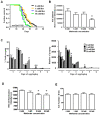Metformin induces a dietary restriction-like state and the oxidative stress response to extend C. elegans Healthspan via AMPK, LKB1, and SKN-1
- PMID: 20090912
- PMCID: PMC2807458
- DOI: 10.1371/journal.pone.0008758
Metformin induces a dietary restriction-like state and the oxidative stress response to extend C. elegans Healthspan via AMPK, LKB1, and SKN-1
Abstract
Metformin, a biguanide drug commonly used to treat type-2 diabetes, has been noted to extend healthspan of nondiabetic mice, but this outcome, and the molecular mechanisms that underlie it, have received relatively little experimental attention. To develop a genetic model for study of biguanide effects on healthspan, we investigated metformin impact on aging Caenorhabditis elegans. We found that metformin increases nematode healthspan, slowing lipofuscin accumulation, extending median lifespan, and prolonging youthful locomotory ability in a dose-dependent manner. Genetic data suggest that metformin acts through a mechanism similar to that operative in eating-impaired dietary restriction (DR) mutants, but independent of the insulin signaling pathway. Energy sensor AMPK and AMPK-activating kinase LKB1, which are activated in mammals by metformin treatment, are essential for health benefits in C. elegans, suggesting that metformin engages a metabolic loop conserved across phyla. We also show that the conserved oxidative stress-responsive transcription factor SKN-1/Nrf2 is essential for metformin healthspan benefits in C. elegans, a mechanistic requirement not previously described in mammals. skn-1, which functions in nematode sensory neurons to promote DR longevity benefits and in intestines for oxidative stress resistance lifespan benefits, must be expressed in both neurons and intestines for metformin-promoted healthspan extension, supporting that metformin improves healthy middle-life aging by activating both DR and antioxidant defense longevity pathways. In addition to defining molecular players operative in metformin healthspan benefits, our data suggest that metformin may be a plausible pharmacological intervention to promote healthy human aging.
Conflict of interest statement
Figures





Similar articles
-
Different dietary restriction regimens extend lifespan by both independent and overlapping genetic pathways in C. elegans.Aging Cell. 2009 Apr;8(2):113-27. doi: 10.1111/j.1474-9726.2009.00459.x. Epub 2009 Feb 23. Aging Cell. 2009. PMID: 19239417 Free PMC article.
-
Metformin retards aging in C. elegans by altering microbial folate and methionine metabolism.Cell. 2013 Mar 28;153(1):228-39. doi: 10.1016/j.cell.2013.02.035. Cell. 2013. PMID: 23540700 Free PMC article.
-
Hydralazine induces stress resistance and extends C. elegans lifespan by activating the NRF2/SKN-1 signalling pathway.Nat Commun. 2017 Dec 20;8(1):2223. doi: 10.1038/s41467-017-02394-3. Nat Commun. 2017. PMID: 29263362 Free PMC article.
-
SKN-1/Nrf, stress responses, and aging in Caenorhabditis elegans.Free Radic Biol Med. 2015 Nov;88(Pt B):290-301. doi: 10.1016/j.freeradbiomed.2015.06.008. Epub 2015 Aug 5. Free Radic Biol Med. 2015. PMID: 26232625 Free PMC article. Review.
-
A Critical Review of the Evidence That Metformin Is a Putative Anti-Aging Drug That Enhances Healthspan and Extends Lifespan.Front Endocrinol (Lausanne). 2021 Aug 5;12:718942. doi: 10.3389/fendo.2021.718942. eCollection 2021. Front Endocrinol (Lausanne). 2021. PMID: 34421827 Free PMC article. Review.
Cited by
-
One-carbon metabolism: an aging-cancer crossroad for the gerosuppressant metformin.Aging (Albany NY). 2012 Dec;4(12):894-8. doi: 10.18632/aging.100523. Aging (Albany NY). 2012. PMID: 23525940 Free PMC article.
-
The endophytic fungus Penicillium oxalicum isolated from Ligusticum chuanxiong Hort possesses DNA damage-protecting potential and increases stress resistance properties in Caenorhabditis elegans.Front Pharmacol. 2022 Aug 30;13:983716. doi: 10.3389/fphar.2022.983716. eCollection 2022. Front Pharmacol. 2022. PMID: 36110524 Free PMC article.
-
Neuroinflammation in Alzheimer's Disease.Biomedicines. 2021 May 7;9(5):524. doi: 10.3390/biomedicines9050524. Biomedicines. 2021. PMID: 34067173 Free PMC article. Review.
-
Neuropeptide Y Overexpressing Female and Male Mice Show Divergent Metabolic but Not Gut Microbial Responses to Prenatal Metformin Exposure.PLoS One. 2016 Sep 28;11(9):e0163805. doi: 10.1371/journal.pone.0163805. eCollection 2016. PLoS One. 2016. PMID: 27681875 Free PMC article.
-
We are all aging, and here's why.Aging Med (Milton). 2022 Oct 3;5(3):211-231. doi: 10.1002/agm2.12223. eCollection 2022 Sep. Aging Med (Milton). 2022. PMID: 36247337 Free PMC article. Review.
References
-
- Eckel RH, Grundy SM, Zimmet PZ. The metabolic syndrome. Lancet. 2005;365:1415–1428. - PubMed
-
- Scarpello JH. Improving survival with metformin: the evidence base today. Diabetes Metab. 2003;29:6S36–43. - PubMed
-
- Anisimov VN. Insulin/IGF-1 signaling pathway driving aging and cancer as a target for pharmacological intervention. Exp Gerontol. 2003;38:1041–1049. - PubMed
-
- Ingram DK, Anson RM, de Cabo R, Mamczarz J, Zhu M, et al. Development of calorie restriction mimetics as a prolongevity strategy. Ann N Y Acad Sci. 2004;1019:412–423. - PubMed
-
- Ingram DK, Zhu M, Mamczarz J, Zou S, Lane MA, et al. Calorie restriction mimetics: an emerging research field. Aging Cell. 2006;5:97–108. - PubMed
Publication types
MeSH terms
Substances
Grants and funding
LinkOut - more resources
Full Text Sources
Other Literature Sources
Medical

